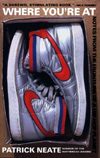




 |
 |
Where You’re At, and Ain’t
Hip-hop’s history anthologized
by Lloyd Babbit
Back in the mid-‘90s, when I was a sophomore in high school, my not-so-informed Spanish teacher once railed against rap music. In between Don Quixote’s ill-fated adventures with windmills, he told my class that, thank God, rap music was on its way out the door culturally. Not one of us believed him.
Today rap, and more importantly hip-hop, is one of the dominant forces in the United States. Yes, hip-hop is the top selling musical genre here. But more than that hip-hop rules culturally. Hip-hop has its own language, its own clothing and haircuts, its own watches and cars, its own symbolism and subcultures. Walk into just about any high school or city in the country and you’ll find it.
Nor is this phenomenon limited to the United States. Hip-hop culture spans the globe, winding its way from New York subways and Knoxville pirate radio broadcasts to South American barrios and Tokyo dance clubs.
Leave it to lifetime hip-hop fan, three-time novelist, and journalist Patrick Neate to investigate the impact and essence of this worldwide hip-hop movement. In Where You’re At: Notes from the Frontline of a Hip-Hop Planet (Riverhead Books, $14), Neate takes us on a five-continent quest in search of hip-hop, culture and meaning.
We begin our global road trip in New York, where hip-hop arguably emerged from its birth canal two decades ago. Here, in a land ruled by bling moguls like Jay-Z, P. Diddy, and 50-Cent, Neate weaves us through the contradictions. It’s a dispirited look at a community’s  values and art slowly suffocating under the weight of MTV, Bentleys and gold jewelry. values and art slowly suffocating under the weight of MTV, Bentleys and gold jewelry.
From hip-hop’s dying homeland it’s off to the Westernized Japanese scene, to Cape Town and Johannesburg, and then Rio, where political and government influence finds a niche in the musical landscape.
As Neate points out in his introduction, what we have here is not an exhaustive academic analysis of global hip-hop; rather it’s a snapshot of where hip-hop is, where it’s going, and where it’s been. Hip-hop is the main character, and we’ve got a front row seat to watch it evolve and devolve from place to place. Neate’s commentary is insightful and pragmatic, and he loops stories of one-man independent labels and ultra-violent dance parties through his narrative skillfully.
Perhaps the only real problem here is what Neate ignores. Snapshot or not, it’s hard to forgive him overlooking, say, militant hip-hop from the Arab world, especially in today’s political climate. Or the differences between New York hip-hop and that of Atlanta or L.A. Still, Neate has penned a fine narrative, one that clear-sightedly reminds us where hip-hip is at, and what that means.
Unlike Neate’s book, which functions as an inquisitive hip-hop travelogue, Lit Riffs (Pocket Books/MTV Books, $14) is a clever literary mix tape. Inspired in part by late rock critic Lester Bangs’ story “Maggie May,” the anthology showcases song-inspired short stories by trendy writers like Tom Perrotta and Amanda Davis.
The riffing starts with the aforementioned “Maggie May.” Part music criticism, part prequel to Rod Stewart’s song of the same name, Bangs takes us on a lust-tinged, booze-gulping tale of an aging prostitute who screws our young hero every which way but loose. Used and abused, loved and hated, Stewart is finally loosed on adult contemporary radio, damning us forever to weepy duets with Bryan Adams.
From there it’s exactly what you should expect from an anthology, especially one based on a gimmick: a bizarre free-for-all. The songs directly inspire some stories, like Amanda Davis’ take on the Cowboy Junkies’ “Blue Guitar.” In Davis’ case that amounts to a semi-famous country singer taking a waitress on a state-line hopping road trip, searching for rescue, redemption, and the best fried catfish you ever ate. Others, like JT Leroy’s “Untitled,” manage to combine the Foo Fighters with dentistry and heavy drug use.
In Perrotta’s “Dirty Mouth,” Tom Petty’s “I Won’t Back Down” springboards a tale of youthful defiance, in which a young boy refuses to say “shit,” despite the taunting of a bully and his thuggish friends. And in Lisa Tucker’s grunge-inspired “Why Go,” sadness and frustration lie just beyond the periphery, as a young, formerly institutionalized girl finds hope and friendship through a Vietnam vet.
Other vignettes are more playful. Hannah Tinti’s “Milestones,” for instance, takes the structure of Miles Davis’ instrumental piece of the same name, and makes it her own, transforming the music into a bustling city street, as we dip in and out of the lives of two men in particular.
This anthology is a mixed bag. Some parts, like those above, are clever, poignant, and insightful, exactly what you’d expect from a mix tape produced by a good friend. Others, like Arthur Bradford’s AC/DC-inspired “Swampthroat,” feel clumsy and out of place. Still, like any good mix tape, this one is worth a listen, if for no other reason than to find out what you should be listening to—but aren’t.

September 16, 2004 • Vol. 14, No. 38
© 2004 Metro Pulse
|
|